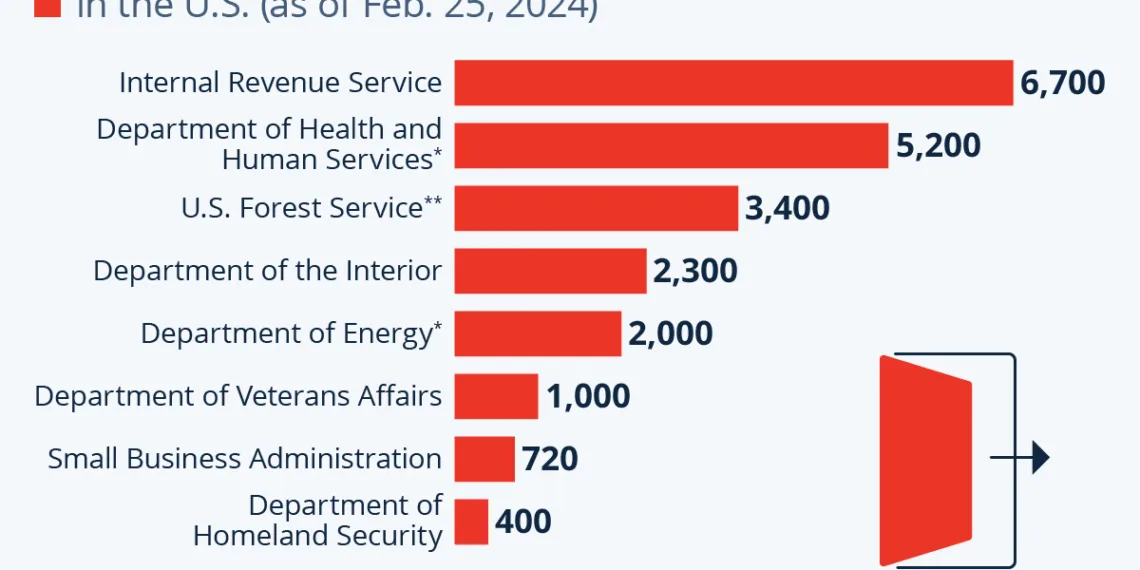Understanding the Federal Layoff Landscape under the Trump Administration
The recent wave of layoffs among federal employees has drawn significant attention, particularly with the Trump administration’s directive to terminate probationary workers across various government agencies. This comprehensive overview provides insight into the scale and implications of these layoffs, particularly at the Internal Revenue Service (IRS) and other federal departments.
Layoffs at the Internal Revenue Service
As part of the government’s cost-cutting measures, the IRS stands out with a staggering report of 6,700 probationary employee layoffs. The Trump administration’s strategy specifically targets employees who lack civil service protections, often due to having less than two years of tenure. The rationale behind this decision is tied closely to budget constraints and a need for efficiency within federal agencies.
Circumstances Surrounding IRS Layoffs
The timing of these layoffs is critical, coinciding with the ongoing tax filing season, which traditionally constitutes one of the busiest periods for the IRS. Notably, roles deemed vital to tax processing and customer service during this peak season are exempt from these layoffs. This exemption indicates a strategic approach, avoiding disruption in essential services while still adhering to the broader policy of workforce reduction.
Broader Layoffs Across Federal Agencies
Beyond the IRS, the layoffs extend to several other notable agencies as the administration seeks to streamline operations. Here’s a closer look at the numbers and effects in various departments.
Department of Health and Human Services
In mid-February, reports indicated that approximately 5,200 employees would receive termination notices from the Department of Health and Human Services (HHS). This plan included substantial cuts at the Centers for Disease Control and Prevention (CDC), where 1,300 jobs—about 10% of the workforce—were at risk. Such cuts raise significant concerns about the agency’s capacity to maintain public health standards amid ongoing health crises.
National Institutes of Health and FDA
The National Institutes of Health (NIH) and the Food and Drug Administration (FDA) also faced staff reductions. Reports indicated layoffs impacting many essential healthcare professionals, including nurses. However, the necessity of certain roles for critical product reviews led to a reversal of some FDA cuts, illustrating the delicate balance between workforce reduction and maintaining public safety and health.
Layoffs in Environmental and National Park Services
The U.S. Forest Service faced significant staffing challenges, with plans to lay off 3,400 employees, accounting for about 10% of its workforce. This decision has raised alarms about the agency’s ability to manage wildfire risks, particularly given the current climate conditions that exacerbate fire threats across the nation.
Impact on Local Communities
The layoffs have broader implications, especially in rural areas that depend heavily on these federal jobs. States like Oregon and Montana, where many federal employees live and work, could see adverse economic impacts from such terminations. Local economies that rely on federal employment may struggle as these layoffs could lead to decreased spending and loss of public services.
Additional Concerns Across Various Departments
The Environmental Protection Agency (EPA) is also under scrutiny for potential layoffs, with similar concerns raised regarding the Department of Homeland Security’s U.S. Cybersecurity and Infrastructure Security Agency and the Federal Aviation Administration (FAA). These terminations have sparked worries about the long-term ramifications for national security and environmental protection.
The Context of Federal Employment Cuts
Despite the substantial numbers, it’s important to place these layoffs in context. Combined with the nearly 75,000 federal employees who accepted buyouts under the Trump administration, the layoffs represent less than 4% of the total 2.4 million non-military and non-postal federal workforce. Such figures reveal ongoing efforts to reshape the federal landscape, but they also highlight potential pitfalls regarding workforce morale and legal challenges stemming from the terminations.
The Legal Landscape of Layoffs
Layoffs of probationary employees can lead to complex legal challenges, especially considering that performance issues have been cited as a reason for many terminations. The potential for appeals against these decisions can complicate the administration’s goals of streamlining government operations. As the administration pushes forward with these layoffs, the impending legal disputes could reshape discussions around federal employment policies moving forward.
Overall Implications for the Federal Workforce
The overarching narrative surrounding these layoffs showcases a pivotal moment for the federal workforce in the United States. While the immediate goal may be financial efficiency, the long-term effects on public service delivery, community stability, and employee morale warrant close attention in these uncertain times. As layoffs continue to unfold across various enforcement and service sectors, the implications for American workers and citizens alike will remain profound and far-reaching.






